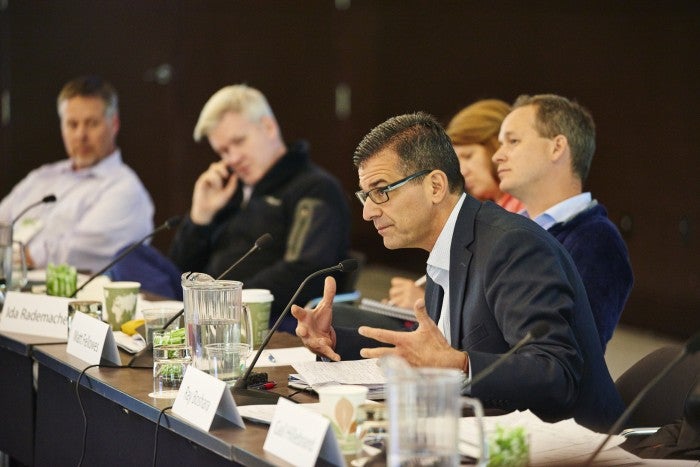The Aspen Initiative on Financial Security held its fourth annual Financial Security Summit in July in Aspen, Colorado. This is the second in a series of seven posts describing each Summit session. Links to the other posts and an overview of the Summit can be found here.
Participants kicked off the panel discussions the morning of July 16th with a session titled, “Converging on a New Vision for Financial Security.” Aspen IFS Executive Director Ida Rademacher moderated a panel featuring Ray Boshara, Senior Advisor and Director at the Federal Reserve Bank of St. Louis; Gail Hillebrand, Associate Director of Consumer Education and Engagement at the Consumer Financial Protection Bureau (CFPB); Matt Fellowes, CEO of HelloWallet; and Corporation for Enterprise Development (CFED) founder Bob Friedman. “Our growing understanding of financial wellbeing as a multifaceted construct compels us to reimagine our definition of financial security,” said Rademacher. Creating a concept of financial security that addresses both short- and long-term needs is an important first step toward change. “As we think about a future field of financial security, we’ve got to have product and policy solutions that bridge all of these gaps,” said Rademacher.

First, Gail Hillebrand introduced the CFPB’s consumer-driven definition of financial wellbeing, “a state of being where a person can meet immediate and ongoing needs, feels secure, and can make good choices.” The CFPB definition is multi-faceted, based on a matrix that incorporates both financial security and freedom to make financial decisions, to meet both short- and long-term needs. Another unique aspect of this definition is the use of subjective measures that attempt to capture how people feel about their financial security. Hillebrand also identified CFPB’s hypothesis for what characteristics are most closely associated with financial wellbeing: people who thought regularly about money management, knew how to ask the right questions, and were able to plan their financial lives (MAP for short, for Management, Asking, and Planning). The CFPB’s next steps are to build a scale to measure financial wellbeing and test the MAP framework.
Next, Ray Boshara presented compelling research from the St. Louis Federal Reserve on the demographic drivers of wealth. The research indicates that fixed determinants of one’s life (e.g. race or age) are becoming increasingly important. According to Boshara, the impact of race was the most “persistent and disturbing” demographic driver. The racial wealth gap has not changed much over twenty-five years, despite gains in education and employment for communities of color. Birth year is a surprisingly powerful predictor of wealth; those born in 1970 are on track to have 40% less wealth than those born in 1940. Education is also strongly correlated with wealth, but not necessarily the cause of wealth. Higher education is a “signal” for other determinants of wealth such as family structure, parental education, ability, and early life experiences. “We think of education as a panacea, but it doesn’t really change the wealth gap at all,” said Boshara. Boshara asserted that these structural determinants of wealth require structural reforms, such as economic empowerment, housing reform, and early childhood resources. Boshara’s remarks set the stage for continued discussion of structural solutions to the wealth gap.
Next, Matt Fellowes discussed the potential role employers can play to advance their employees’ financial wellbeing. More companies are becoming interested in improving their employees’ financial health, especially as the workforce ages and retirement security becomes a critical issue. Employers can use the data accumulated in financial wellness programs like HelloWallet to design better compensation and benefit programs. “Human Resources departments are thinking much more progressively than ever before about how they can use every dollar for compensation and benefits in a way that maximizes the return for the individual,” said Fellowes. Fellowes gave an example of one company that discovered that a number of its workers were spending a large amount of their salaries on overdraft fees, and used this data to push for banking reforms.
Bob Friedman offered a perspective of financial wellbeing that is centered on respect for and belief in individual aspirations and capacity. Friedman challenged policymakers to start from the premise that people know their own goals and will work toward them if given a real opportunity. The objective of policy should be to help them achieve those goals by providing broad access to asset-building opportunities. Policies that offer even small financial incentives to save and invest can give people a leg up and transform their lives. The self-defined frame for financial wellbeing “helps us focus on the talents and dreams and energy that people bring to the table, rather than their disabilities,” said Friedman.
In the group discussion that followed, participants emphasized holistic and structural definitions of financial wellbeing. Jason Fichtner applauded the CFPB for thinking comprehensively about solutions to financial insecurity. “Make rules, make them simple to understand, enforce them, but empower people at the same time,” advised Fichtner. Maya Rockeymoore and Bill Spriggs echoed the importance of examining structural and demographic drivers of disparate wealth accumulation. “The entire marketplace is a minefield for minorities,” said Rockeymoore. The discrimination discussion “needs its own focus and centrality,” agreed Spriggs.
Watch the video footage from this session here.

